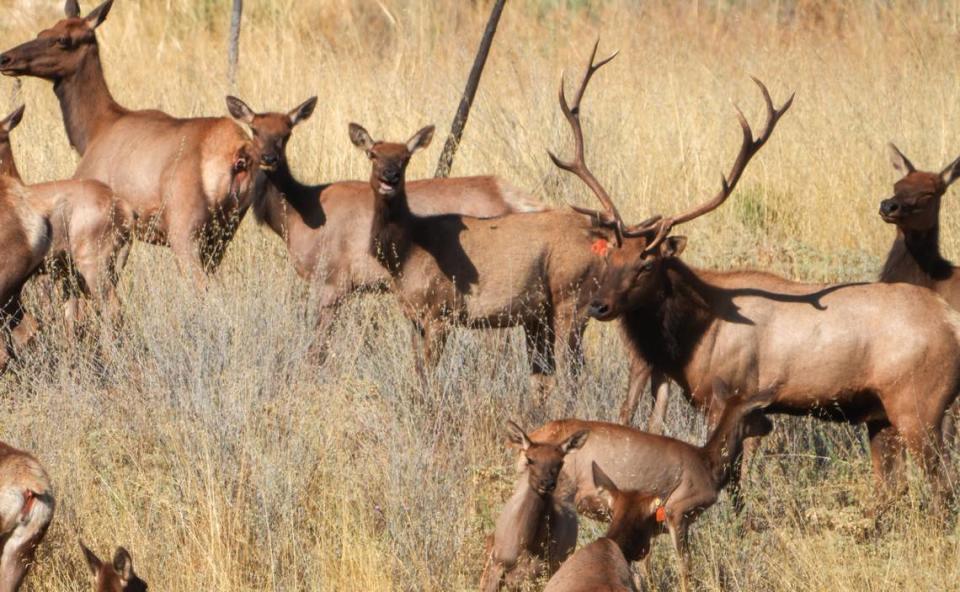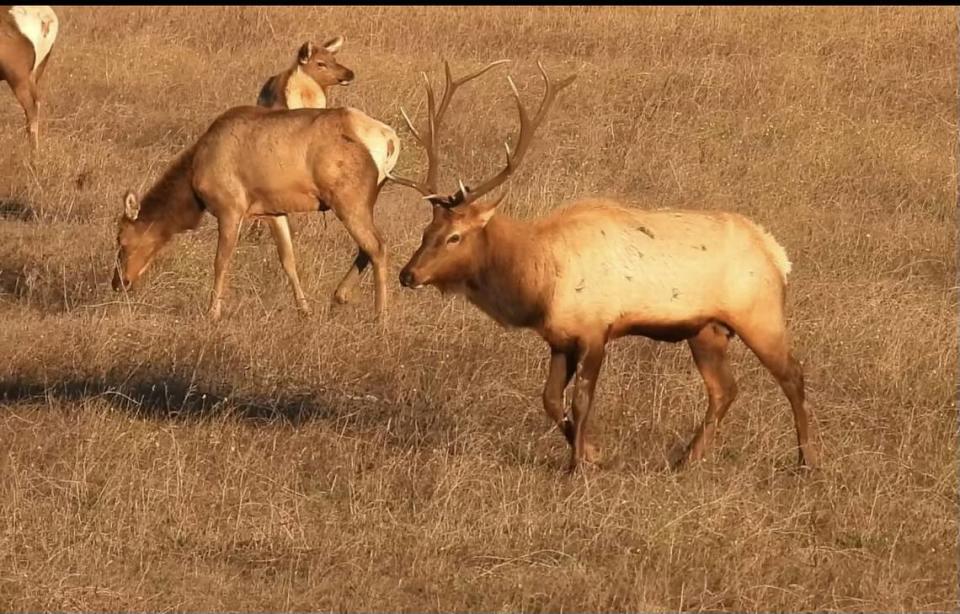What to know about viewing, hunting elk in San Luis Obispo County
- Oops!Something went wrong.Please try again later.
Longing for a local wildlife adventure this holiday season?
Healthy herds of wild, free-roaming Grant’s zebras, Roosevelt elk and Barbary sheep (aoudads) graze the sprawling 83,000-acre Hearst Ranch, delighting Highway 1 sightseers north of Cambria.
How did those wild animals get there?
Credit goes to William Randolph Hearst, newspaper publisher, creator of Hearst Castle, and founder of the largest private zoo in the world in the 1930s.
When Hearst’s zoo (“The Hearst Garden of Comparative Zoology”) was disbanded in 1937 — due to reported financial constraints — the publishing magnate released the zebras, elk and aoudads into the expansive ranch to roam wild and free.
The remaining zoo animals — kangaroos, camels, ostriches, giraffes, antelope, lions, elephants and polar bears — were “sold or otherwise transferred to other zoos,” according to Hearst Ranch’s director of agricultural operations, Ben Higgins.
Meantime, since Hearst paid it forward 86 years ago — for folks who have perhaps never seen zebras, elk or Barbary sheep — an uncommon natural world encounter is within reach in San Luis Obispo County.
There are approximately 135 zebras (best seen on the east side of Highway 1 before the Castle); roughly 155 Barbary sheep (sometimes hidden from view); and about 130 Roosevelt elk (seen on the east side of the highway a few miles past the elephant seal rookery).
Elk are among the largest members of the cervidae species (moose, caribou, deer and elk). A fully grown Roosevelt bull can weight up to 1,100 pounds, stand up to 5.6 feet at the highest part of their back and grow to 8.5 feet long.
Typically Roosevelt elk — non-native to the county, believed to be brought from the Pacific Northwest for Hearst’s zoo — graze within the fenced boundaries (to restrict cattle movement) on Hearst Ranch.
But, as Higgins explains in an email, “The elk can easily go over — and even through, on occasion — our fences. And it’s common in fact to see them on the west side of Highway 1, which is owned and managed by the California Department of Parks and Recreation.”
The Roosevelt elk graze on native grasses and have plentiful sources of water, thanks to the troughs and stock ponds Hearst developed “principally for cattle and to protect water quality in our sensitive watersheds,” Higgins said.
The Hearst Ranch — stretching from the Monterey County border to south of San Simeon — is “one of the oldest and largest working cattle ranches on the California coast,” Higgins said.

Where else are elk found in SLO County?
Wildlife biologist Brandon Swanson — who has responsibility for “all wildlife” in San Luis Obispo County’s 3,616 square miles — reports there are approximately 1,300 tule elk in the county.
Tule elk herds are found in the La Panza area, in the Carrizo Plain (one in the north end and one in the south end), on Fort Hunter Liggett (which borders the Hearst Ranch to the north), Camp Roberts, California Valley and the Jack Ranch near the junction of Highways 41 and 46 (owned by Hearst).
Elk have a 280-degree field of view, Swanson said.
“Elk lack the visual acuity humans have — they see in 20/40 vision — but they can detect movement as far as 900 yards away,” Swanson said.
Swanson added that “elk have also been shown to exhibit object permanence” — knowing an object exists when it is hidden.
Bull elk often have 10-to-12-point antlers, grown new each year.
Elk cows have one calf annually, if the bull that “controls a large group of cows” gets them pregnant. Because of the number of cows that bulls control, “some cows might not get as much attention,” Swanson said.

Where to hunt elk in SLO County
“A big part of my job is monitoring the annual elk hunt,” Swanson said.
Resident gun hunters in the La Panza hunt zone (including the counties of San Luis Obispo, Monterey and San Benito) pay $25.41 per Tule tag; junior residents (16 and under) pay $544.80 per tag; and non- residents shell out $1,700.35 for a tag, according to the California Department of Fish and Wildlife.
Fort Hunter Liggett’s season for tule bulls is Dec. 19 to 31; for cows it is Nov. 22 to 30. The Central Coast region’s season for bulls and cows is Oct. 7 through Dec. 5.
This season’s take through November, Swanson reported, was five bulls and five cows in the La Panza range, and four bulls and four cows in the Central Coast range.
In the meantime, does the Hearst Ranch allow elk hunting? Yes, Higgins said. Hearst has up to two hunts annually.
“We are participants in the California Department Fish and Wildlife’s ‘Private Lands Management’ program, whereby we receive elk tags in exchange for certain land management practices,” he said.
Hearst’s chosen outfitter is Kika Worldwide, Higgins said.
What are the health benefits of elk meat?
WebMD Registered Dietitian Christine Mikstas wrote in a May 2022 report that elk meat is “low in fat, rich in protein, with no carbohydrates, a healthy option for your table; elk meat flavor is like mild beef, almost sweet.”
Wild elk are grass-fed (they eat grasses, shrubs, and trees) and have “a higher proportion of polyunsaturated fatty acids, which are healthier than beef,” Mikstas wrote.
Wild elk meat has 111 calories per 100 grams, “one of the lowest of all red meats,” Mikstas continued. She also said it has iron, calcium, copper, magnesium, manganese, phosphorus, potassium, selenium and zinc.
“People overwhelmingly prefer elk to venison,” Higgins said. “Though all things being equal, the difference is generally smaller than perceived.”
How to view Roosevelt elk at Hearst Ranch
While the Roosevelt herd, a few miles north of the Piedras Blancas Lighthouse on the east side of Highway 1, can be seen without binoculars, to get usable pictures a good camera with a long-range lens is the best bet.
Smartphone cameras can capture the herd, but the distance is too great for quality images.
And, trying to get closer to the herd is very risky.
“It is not a good idea to try and approach an elk,” Swanson said. “While they are most likely to run away, they are very large animals equipped with antlers that can be deadly.”

